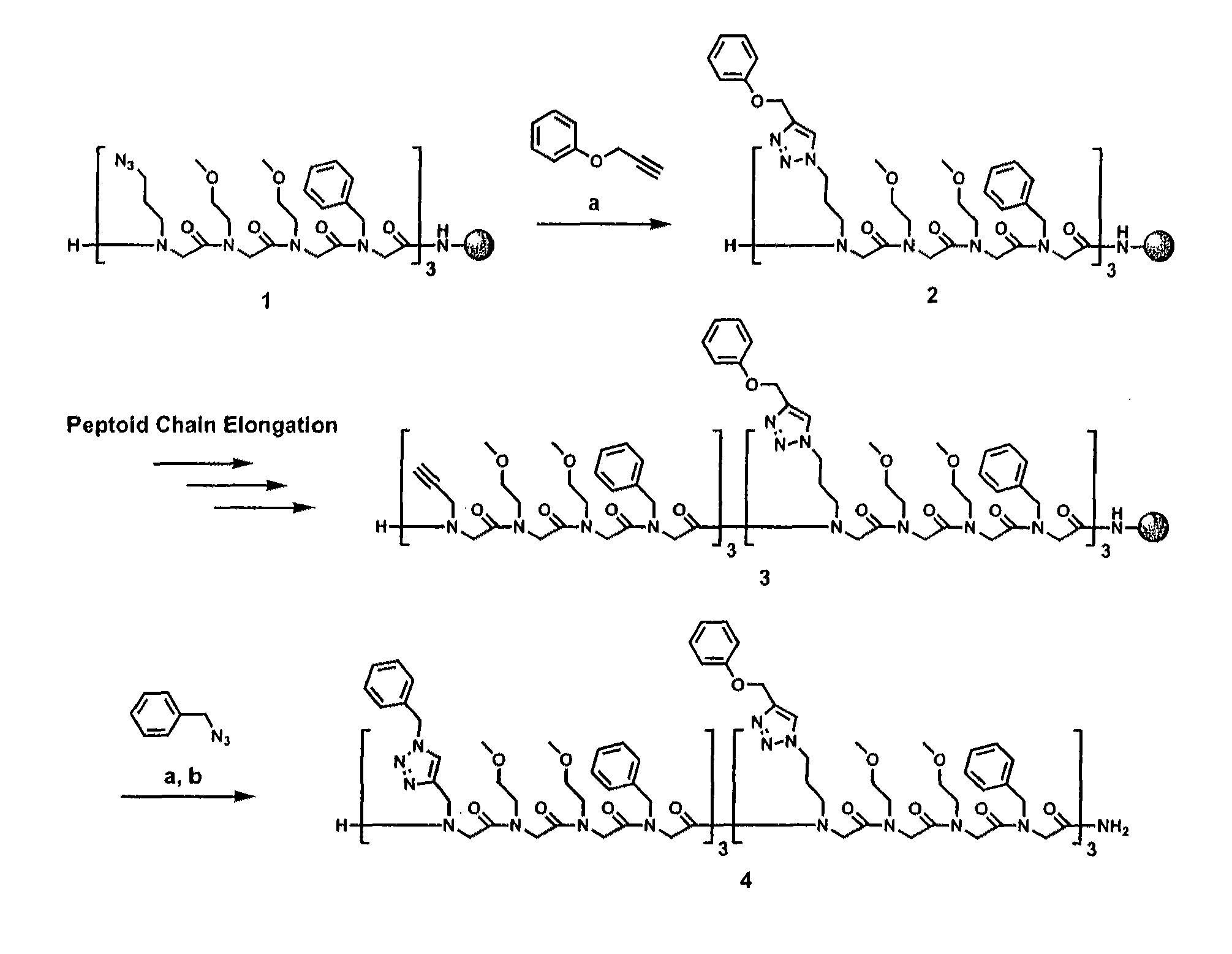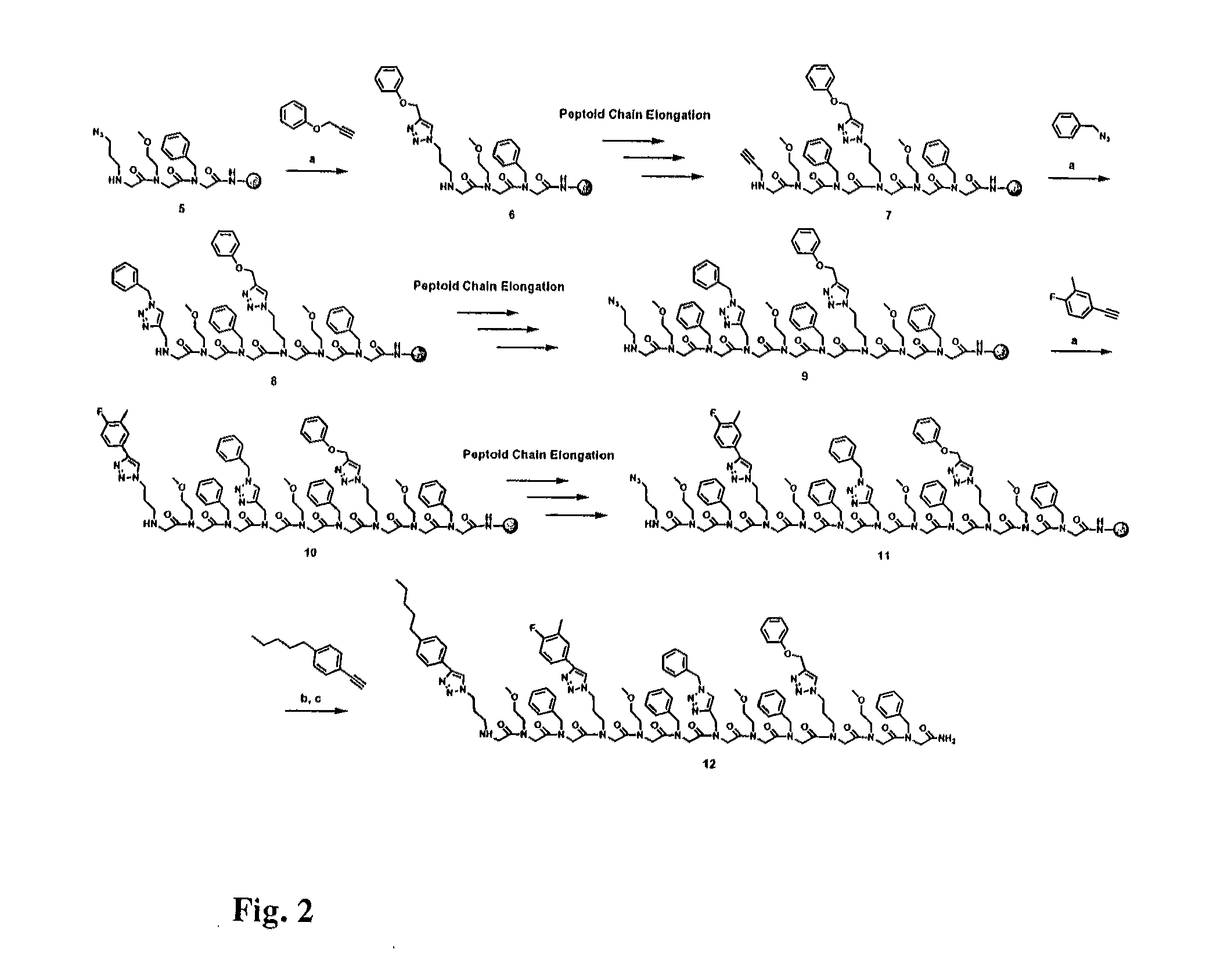Method for site-specific polyvalent display on polymers
a polymer and site-specific technology, applied in the direction of peptide/protein ingredients, peptide sources, drug compositions, etc., can solve the problems of poor pharmacological properties and product limitations, and achieve the effect of facilitating automation
- Summary
- Abstract
- Description
- Claims
- Application Information
AI Technical Summary
Benefits of technology
Problems solved by technology
Method used
Image
Examples
example i
Methods and Materials
[0066]General:
[0067]Peptoid oligomers were characterized by analytical Reversed-Phase High Performance Liquid Chromatography (RP-HPLC) using a C4 column (Peeke Scientific, Ultra-120, 5 μm, 120 Å, 2.0×50 mm) on a Beckman Coulter System Gold HPLC system. Products were detected by UV absorbance at 214 nm with a System Gold 166 detector. Data were analyzed with Beckman Coulter 32 Karat software version 5.0. Unless otherwise noted, linear gradients were conducted from 5% to 95% solvent B (0.1% TFA in HPLC grade acetonitrile) over solvent A (0.1% TFA in HPLC grade water) in 10 minutes with a flow rate of 0.7 mL min−1. Subsequent chain elongation and average coupling yields were estimated by RP-HPLC using methods described previously by Jang et al. (supra).
[0068]Additional characterization of peptoid oligomers was conducted using Liquid Chromatography / Mass Spectrometry (LC / MS). All peptoids described herein were analyzed using an Agilent 1100 Series LC / MSD Trap XCT equ...
example ii
[0088]The present invention is directed to a novel method for generating compounds for polyvalent display. In particular, the present inventors describe an implementation that allows synthesis of relatively inexpensive and biologically relevant hormone-dependent agents that exhibit significant advantages over those previously described in the literature. Peptidomimetic scaffolds outfitted, for example, with multiple 17α-ethynylestradiol and ferrocene functionalities can be generated with minimal effort and cost. See FIG. 6, wherein a general method for synthesis of polyvalent selective hormone receptor cytotoxic agents is shown. Triazole linkages between the ligand and scaffold are formed in highly regiospecific, thermodynamically favorable conjugation reactions that occur at room temperature in organic or aqueous solvents. Furthermore, the scaffolds used are N-substituted glycine oligomers (peptoids), which may prove beneficial in vivo due to their enhanced resistance to proteolyti...
example iii
[0092]Additional applications of the invention include the synthesis of molecules with high affinity for a variety of biological targets, which exhibit such high affinity as a consequence of the polyvalent display of select conjugated binding groups on a linear oligomeric scaffold. The term polyvalency is used herein to refer to high-affinity binding between surfaces wherein the affinity is conferred at least in part by the binding of repeated epitopes. It is noteworthy that polyvalency is a defining characteristic of the surfaces of almost all invading pathogens. In addition, other applications include highly potent pharmaceuticals, whose therapeutic activity is anticipated to be enhanced due to the multiple presentation of cytotoxic moieties. Important applications in the field of biosensors, diagnostic agents, and molecular imaging probes are also encompassed by the present invention.
[0093]Targeting Viral Pathogens:
[0094]Viral molecules, particularly those displayed on a viral ca...
PUM
| Property | Measurement | Unit |
|---|---|---|
| flow rate | aaaaa | aaaaa |
| concentration | aaaaa | aaaaa |
| concentration | aaaaa | aaaaa |
Abstract
Description
Claims
Application Information
 Login to View More
Login to View More - R&D
- Intellectual Property
- Life Sciences
- Materials
- Tech Scout
- Unparalleled Data Quality
- Higher Quality Content
- 60% Fewer Hallucinations
Browse by: Latest US Patents, China's latest patents, Technical Efficacy Thesaurus, Application Domain, Technology Topic, Popular Technical Reports.
© 2025 PatSnap. All rights reserved.Legal|Privacy policy|Modern Slavery Act Transparency Statement|Sitemap|About US| Contact US: help@patsnap.com



